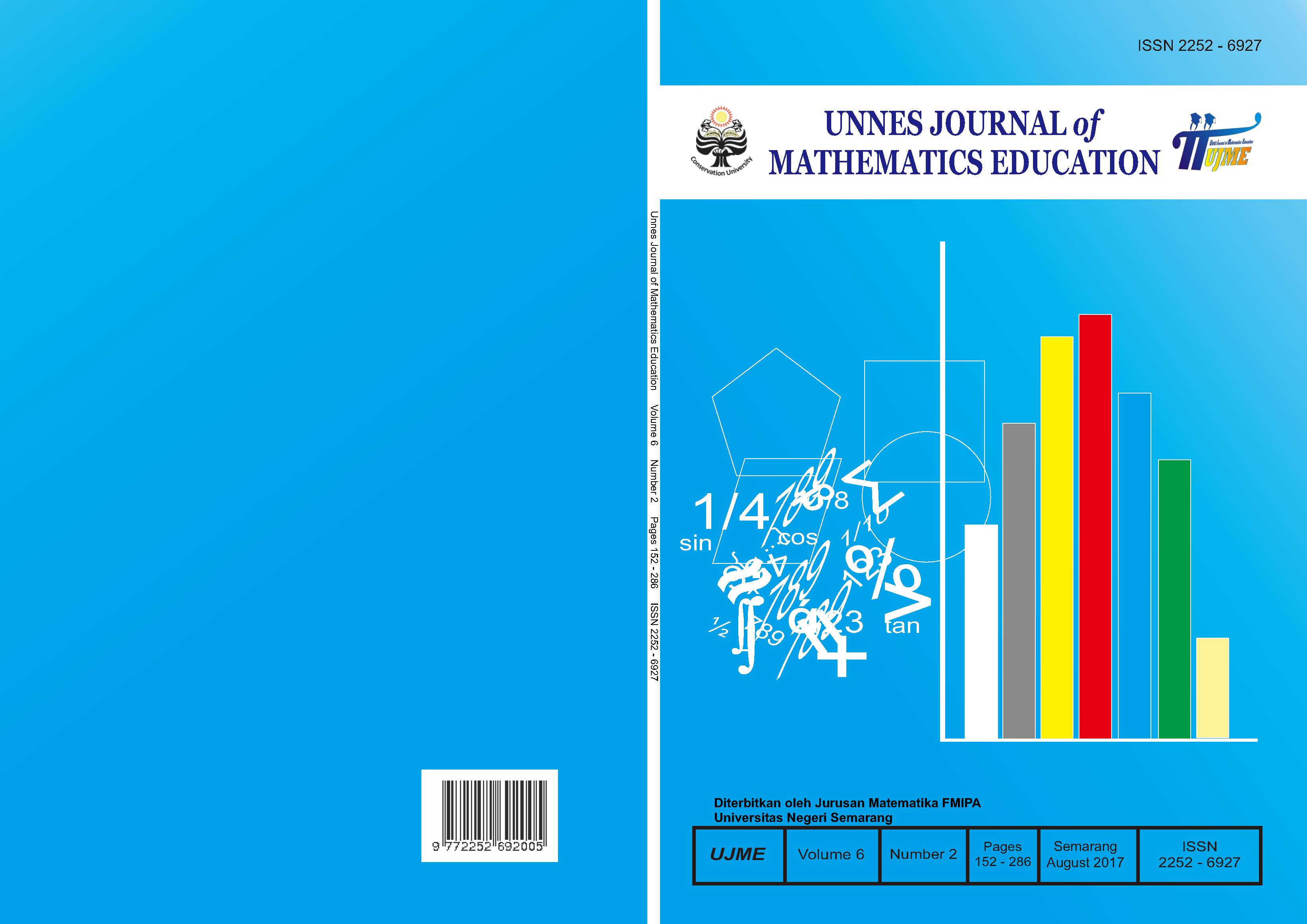Effectiveness of POGIL Learning Model with Ethnomathematics Nuance Assisted by Student Worksheet toward Student Mathematical Communication Skill
##plugins.themes.academic_pro.article.main##
Abstract
The purpose of this study was to analyzing the effectiveness of POGIL model learning with ethnomathematics nuance by using student worksheets towards student’s mathematical communication ability in quadraliteral materialand. The population in this research was the students of seventh grade Junior High School 1 Welahan on year 2016/2017. By using simple random sampling, the selected samples were VII-A as control class with PBL model learning and VII-B as experiment class with POGIL model learning with nuance ethnomathematics by using student worksheet. The methods which have been used to collect data were documentation, test, and questionnaire. Data were analyzed using proportion test, independent samples t-test, and linear regression. The result of research showed that (1) Student’s mathematical communication ability which have studied with POGIL model learning with ethnomathematics nuance by using student worksheets reach the minimum score criteria, (2) The average of student’s mathematical communication ability by implementing POGIL model learning with ethnomathematics nuance by using student worksheets better than the average of student’s mathematical communication ability by implementing PBL model learning, (3) Respect to local culture attitude influenced toward mathematical communication ability with the number 55,5%.
##plugins.themes.academic_pro.article.details##
References
Cai, J., M. S. Jacabcsin, & S. Lane. (1996). Assasing Students’ Mathematical Communication. School Science and Mathematics, 96(5): 238-246.
D’Ambrosio, U. (1985). Ethnomathematics and its place in the history and pedagogy of mathematics. For the learning of Mathematics, 5(l): 44-48.
Dinas Perhubungan dan Pariwisata Kabupaten Jepara. (2003). Jepara Sejarah & Budaya. Jepara: Dinas Perhubungan dan Pariwisata Kabupaten Jepara.
Fadilah, N. (2015). Peningkatan Karakter Percaya Diri dan Kemampuan Komunikasi Matematika melalui Model Probing Prompting dengan Asesmen Otentik. Skripsi. Semarang: Universitas Negeri Semarang.
Fujiati, I. & Mastur, Z. (2014). Keefektifan Model POGIL Berbantuan Alat Peraga Matematika Terhadap Kemampuan Komunikasi Matematis. Unnes Journal of Mathematics Education, 3(3): 174-180.
Hanson, David M. (2006). Instructors Guided to Process Oriented Guided-Inquiry Learning. Lisle, IL: Pacific Crest.
Menteri Pendidikan dan Kebudayaan. 2014. Lampiran Peraturan Menteri Pendidikan dan Kebudayaan Republik Indonesia Nomor 58 Tahun 2014 Tentang Kurikulum 2013 Sekolah Menengah Pertama/Madrasah Tsanawiyah. Jakarta: Kemendikbud.
Munawar, H. A., Wuryanto, & M. Asikin. (2013). Keefektifan Pendekatan Aptitude Treatment Interaction Berbantuan CD Interaktif terhadap Kemampuan Komunikasi Matematis Peserta Didik Sekolah Menengah Pertama. Unnes Journal of Mathematics Education, 2(1): 96-104.
NCTM. (2000). Principles and Standards for School Mathematics. Reston, VA: Authur.
Oktaviani, R., H. Suyitno, & Mashuri. (2016). Keefektifan Model Elicing Activities Berbantuan LKPD terhadap Kemampuan Komunikasi Matematis dan Disposisi Matematis Peserta Didik Kelas VII. Unnes Journal of Mathematics Education, 5(3): 190-198.
Rosidah. (2013). Keefektifan Model Pembelajaran POGIL Berbantuan LKPD Terhadap Kemampuan Pemecahan Masalah Materi Pokok Peluang. Kreano, 4(1): 73-79.
Sugiarto. (2010). Workshop Pendidikan Matematika II. Semarang: UNNES.
Sugiyono. (2015). Metode Penelitian Pendidikan Pendekatan Kuantitatif, Kualitatif, dan R & D. Bandung: Alfabeta
Utari, T. (2015). Keefektifan Model Pembelajaran Probing-Prompting Berbasis Etnomatematika Untuk Meningkatkan Kemampuan Komunikasi Matematis. Skripsi. Semarang: Universitas Negeri Semarang.
